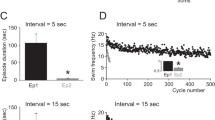Summary
-
1.
Rapid adductions of the shell valves in the scallop (Aequipecten) are associated with large electrical transients in the fast portion of the adductor muscle. It is assumed that these are muscle action potentials and accurately reflect volley frequency in the motor nerves to the muscle.
-
2.
During swimming behavior a rhythmic motor output occurs, the frequency of which can he altered by procedures which damp or assist movements of the shell valves relative to each other.
-
3.
Adequate stretch of the fast adductor muscle is necessary for the occurrence of rhythmic motor output. However, even in the stretched condition, sustained rhythmic output must be phased by some relative valve movement.
-
4.
Swimming behavior is most simply considered to be the result of the alternate release of energy in the resilium and the fast adductor; these elements constitute a relaxation oscillator which operates at a characteristic frequency until fast muscle stretch is damped by activity of the slow adductor, or until phasic input to the central nervous system from the muscle sensory systems is adapted out.
Similar content being viewed by others
References
Barnes, G. E.: Rhythmical activity in Anodonta. Proc. Linnean Soc. London 165, 1 (1952).
Bennett, M. V. L., G. D. Pappas, E. Aljure, and Y. Nakajima: Physiology and ultrastructure of electrotonic junctions. II. Spinal and medullary electromotor nuclei in Mormyrid fish. J. Neurophysiol. 30, 180–208 (1967).
Horridge, G. A.: The centrally determined sequence of impulses initiated from a ganglion of the clam, Mya. J. Physiol. (Lond.) 155, 320–326 (1961).
Ikeda, K., and C. A. G. Wiersma: Autogenic rhythmicity in the abdominal ganglia of the crayfish; the control of swimmeret movements. Comp. Biochem. Physiol. 12, 107–115 (1964).
Katz, B.: The efferent regulation of the muscle spindle in the frog. J. exp. Biol. 26, 201–217 (1949).
Lowy, J.: Contraction and relaxation in the adductor muscles of Pecten maximus. J. Physiol. (Lond.) 124, 100–105 (1954).
Mellon, De Forest: Junctional physiology and motor nerve distribution in the fast adductor muscle of the scallop. Science 160, 1018–1020 (1968).
—, and G. J. Mpitsos: Response heterogeneity in adductor muscle efferents of the surf clam. J. exp. Biol. 46, 585–597 (1967).
Mendelson, M.: Personal communication.
Strumwasser, F.: Membrane and intracellular mechanisms governing endogeneous activity in neurons. In: Physiological and biochemical aspects of nervous integration (F. D. Carlson, ed.). Englewood Cliffs, New Jersey: Prentice-Hall 1968.
Trueman, B. R.: The dynamics of burrowing of some common littoral bivalves. J. exp. Biol. 44, 469–492 (1965).
Willows, A. O. D.: Behavioral acts elicited by stimulation of single identifiable nerve cells. In: Physiological and biochemical aspects of nervous integration (F. D, Carlson, ed.). Englewood Cliffs, New Jersey: Prentice-Hall 1968.
Wilson, D. M.: The central nervous control of flight in a locust. J. exp. Biol. 38, 471–490 (1961).
—, and R. J. Wyman: Motor output patterns during random and rhythmic stimulation of locust thoracic ganglia. Biophys. J. 5, 121–143 (1965).
Author information
Authors and Affiliations
Additional information
I am indebted to Drs. DONALD KENNEDY and DONALD M. WILSON for reading, with a critical eye, an early draft of this paper and for suggesting the experiments resulting in Figure 8. This research was supported by grant No. NB 04989-05 from the National Institute of Neurological Diseases and Blindness, USPHS.
Rights and permissions
About this article
Cite this article
De Mellon, F. The reflex control of rhythmic motor output during swimming in the scallop. Z. Vergl. Physiol. 62, 318–336 (1969). https://doi.org/10.1007/BF00395744
Received:
Issue Date:
DOI: https://doi.org/10.1007/BF00395744




